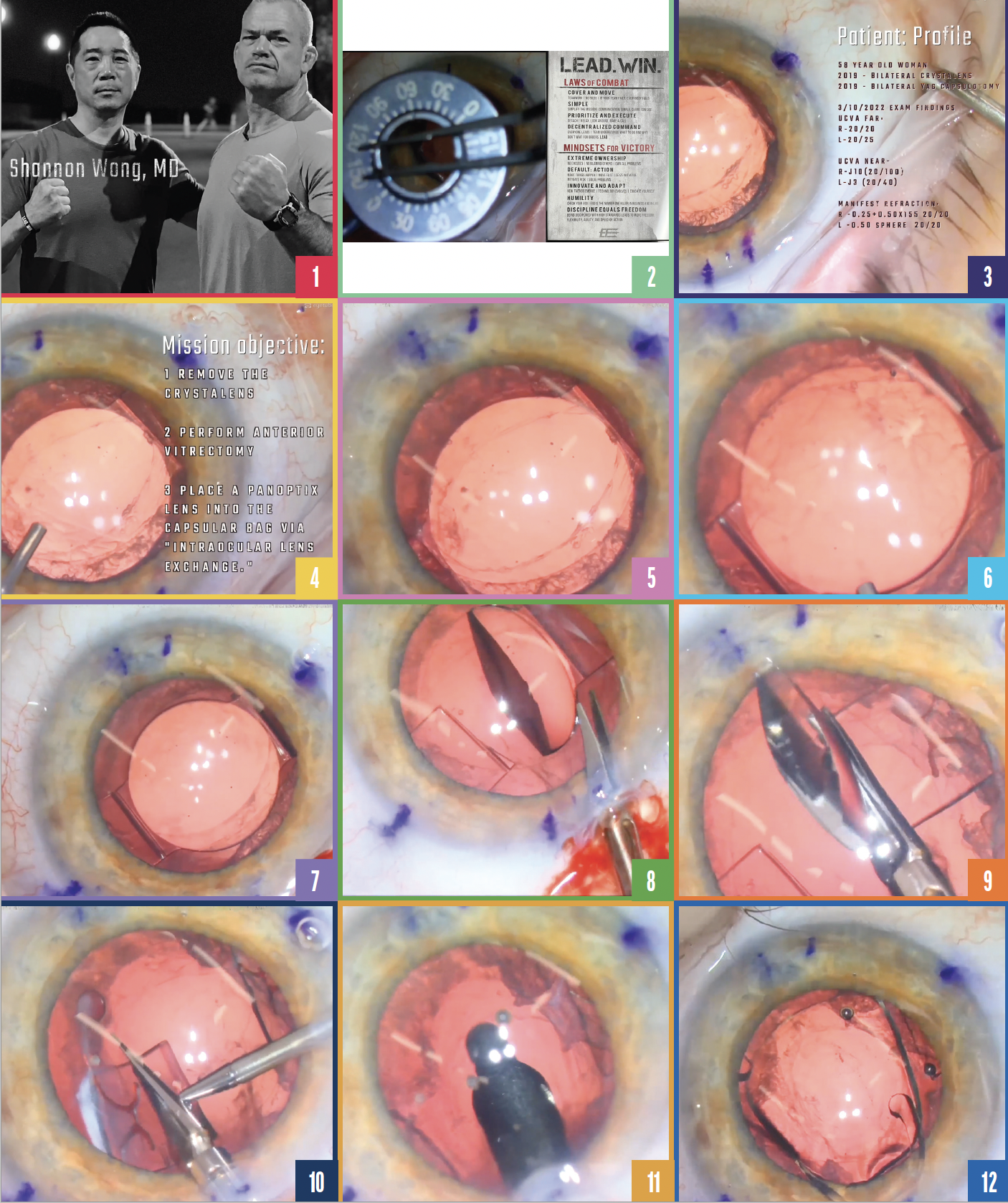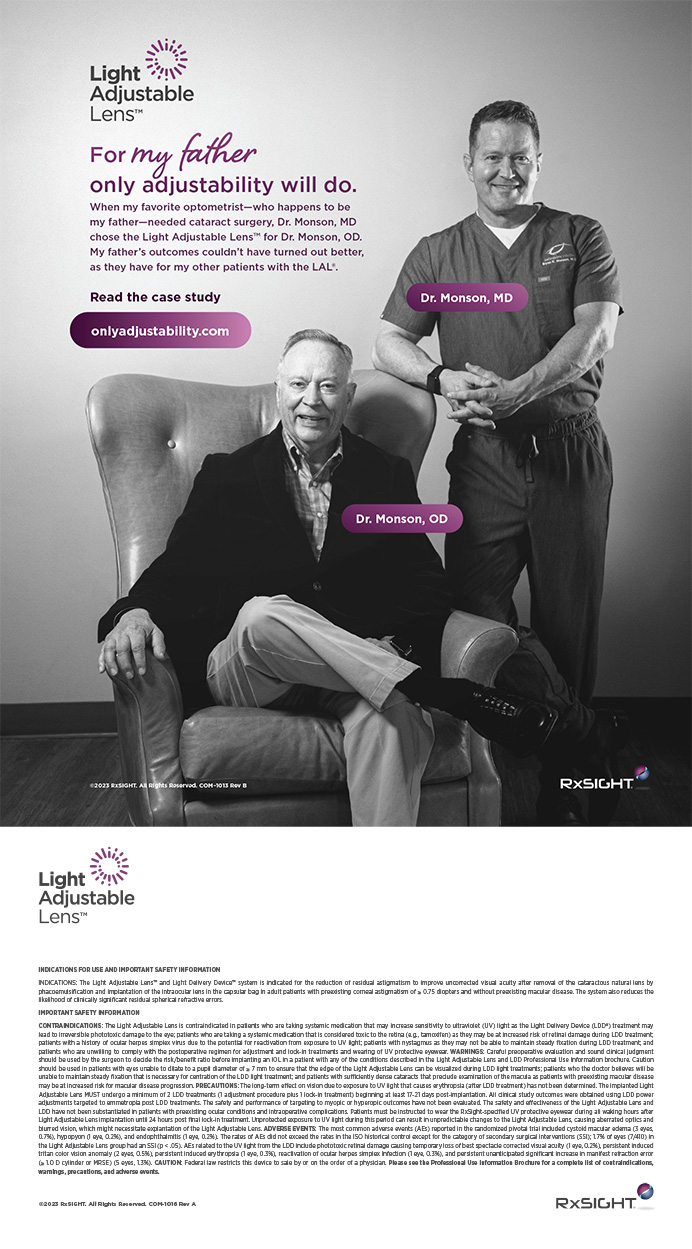One of the most influential people in my life is Jocko Willink, a retired US Navy officer who has written numerous books that apply lessons on leadership learned from his combat experience with the Navy SEALs to business and life. I have found that applying Jocko’s five mindsets for victory and the four laws of combat to my business and profession allows me to have a greater impact on the battlefield of life (Figure 1 and Figure 2).1 A case example illustrates my approach.

Figure 1. Dr. Wong and Jocko Willink.
Figure 2. Dr. Wong applies the five mindsets for victory and the four laws of combat to eye surgery. The poster to the right hangs on a wall in Dr. Wong’s office.
Figure 3. The patient’s preoperative measurements.
Figure 4. Case objectives.
Figure 5. The eye before IOL exchange.
Figure 6. The IOL is viscodissected from the capsular bag.
Figure 7. A plan and backup plans were formulated.
Figure 8. Fibrosis around one of the haptics leads to its amputation so that the Crystalens can be removed.
Figure 9. The right haptic is fibrosed into the capsular bag equator.
Figure 10. The haptics are trimmed because they cannot be removed owing to fibrosis.
Figure 11. An anterior vitrectomy is performed.
Figure 12. A PanOptix IOL is placed in the capsular bag, and its haptics are oriented 90º away from the amputated haptics of the Crystalens.
CASE PRESENTATION
A 58-year-old woman seeking improved vision presented to my practice in March 2022. The patient had a Crystalens (Bausch + Lomb) and received an Nd:YAG laser capsulotomy in each eye (Figure 3). She wanted to be able to read, drive, and see a golf ball on the fairway without spectacle correction, and she was really tired of relying on numerous sets of reading glasses.
I told her that her vision was pretty good and advised her to leave her eyes alone. She did not accept my recommendation. After a long discussion of the pros, cons, and risks, she decided to proceed with an IOL exchange for a Clareon PanOptix IOL (Alcon) in her left eye (Figure 4). The video of her surgery is the inspiration for my timeless tip (watch below).
THE FIVE MINDSETS FOR VICTORY
No. 1: Humility. Even the greatest surgeon in the world cannot make every patient happy with their vision. I am humble enough to politely decline a patient’s irrational or unreasonable request (Figure 5).
I had performed hundreds of IOL exchanges before this patient’s, but I kept my ego in check. I advised the patient not to have surgery because I sensed that her expectations might be higher than I could meet. I counseled her appropriately. Ultimately, she accepted the uncertainty inherent in an IOL exchange and decided to undergo surgery to improve the uncorrected near and distance vision in her left eye.
No. 2: Innovate and adapt. During my career, I have learned to accept being uncomfortable as I expand and improve my skills as a surgeon. I work hard to discover solutions to difficult or complex situations such as this patient’s (Figure 6). The concept of learning to become comfortable being uncomfortable—both as a human and an eye surgeon—applies. There is a saying I like to use, “Where there is not stress, there is no progress.” The most effective way for us to improve as eye surgeons is to find solutions to difficult problems such as the scenario with this patient.
No. 3: Extreme ownership. Once I agreed to perform the surgery, I took ownership of the situation and formulated a plan and backup plans. Once I began performing surgery, it was my job to help the patient achieve her goal. I understood that I could not make excuses or blame others if the outcome did not meet her expectations. I took responsibility for the success or failure of the mission, the surgical procedure, and the outcome (Figure 7).
The pupil was dilated during the preoperative examination so I could assess the dimensions and condition of the capsular bag. It looked stiff and fibrotic through the slit-lamp microscope. The capsular axis opening was centered. The information helped facilitate surgical planning and improved the chances of a successful outcome.
Plan A was to remove the Crystalens and implant a PanOptix in the capsular bag. Plan B was to remove the Crystalens and reverse optic capture a PanOptix so that its haptics were inside the bag and the optic was anterior to the capsular axis. If the patient was unhappy after surgery, plan C was to perform a LASIK enhancement or an additional IOL procedure, perhaps with a Clareon Vivity (Alcon) if she was dissatisfied with the PanOptix.
No. 4: Default: Action. A leader is proactive. I like to say that prior preparation prevents poor performance. The refractive target was emmetropia. Biometry was performed with a Lenstar LS900 (Haag-Streit USA). IOL calculations were performed with the Holladay 2 formula for pseudophakic eyes with an acrylic IOL. Calculations for plan B were then performed on www.doctor-hill.com to determine the IOL power that would be required if the optic were placed in the sulcus.
No. 5: Discipline equals freedom. Many surgeons would not have agreed to operate on the patient. She was demanding and had high expectations, and she saw well enough. She was also, however, extremely frustrated with her vision, highly motivated to undergo surgery, and ultimately accepting of the uncertainty of her outcome (Figure 8, Figure 9, Figure 10, Figure 11, and Figure 12).
Discipline and a commitment to high standards allow leaders to be successful. I have invested a lot of time and effort into improving how I communicate with patients, developing my surgical skills, and building a surgical team and practice that can help individuals like this patient. I therefore believed there was a high chance we would meet her expectations.
THE FOUR LAWS OF COMBAT
No. 1: Prioritize and execute. Trying to address too many issues at once is counterproductive. During surgery, I stay focused but also remain detached. My becoming anxious or emotional will not help the patient, my surgical team, or me during the procedure.
It has taken me 25 years to learn how to control my emotions during difficult situations. During the case, I tuned out negativity and stayed calm while methodically moving through the steps of surgery.
No. 2: Decentralized command. My administrative staff, surgical coordinators, technicians, and nurses strive to deliver the best possible experience to patients. Training my team through effective leadership has been the most important contributor to the success of my organization. They are empowered and incentivized to deliver outstanding service.
Surgeons are only one factor in the delivery of excellent care. If the surgical team lacks training and does not understand the organization’s mission, then patients will not receive the best care. Developing our team and defining our mission are the most important responsibilities I have as the CEO of our organization. Our surgical team understands decentralized command, and the surgeon can therefore focus on the task at hand while the team supports the surgeon without direct supervision or instruction.
No. 3: Simple. A plan must be straightforward so that everyone understands and can execute it. My organization’s mission is simple: to provide the best, most compassionate care possible at all levels—customer service, administrative support, billing, medical services, and surgical care. Our organization’s mission is to be an elite cataract and refractive practice. Individuals in our organization always go above and beyond to surgically optimize vision for our patients, such as the patient in this case.
No. 4: Cover and move. Teamwork is key to our organization’s success. Cross-training allows staff members to cover for an absent employee. Low performers are held to account because, if one person fails, then we all fail. Either that employee’s skills and performance are enhanced to meet our organization’s high standards, or the person is replaced.
CONCLUSION
Two weeks after surgery, the patient’s uncorrected distance visual acuity was 20/20, her uncorrected near visual acuity was 20/20 (J1), and she had a plano refraction. She could see a golf ball on the fairway and read without glasses. She was happy with her outcome.
1. Willink J, Babin L. Extreme Ownership. St. Martin’s Press; 2017.




